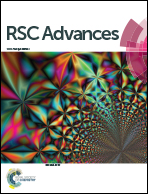A unusual two-dimensional azido-Cu(ii) network with benzoate derivative as a co-ligand exhibiting ferromagnetic order and slow magnetic relaxation†
Abstract
A 2D layer-like azido-copper system was constructed from linear tetranuclear metal motif with mixed-ligand bridges of carboxylate, azido and hydroxyl groups. The strong ferromagnetic coupling between Cu(II) ions was due to the counter complementarity of the multiple super-exchange pathways, leading to a dramatic magnetic order and slow relaxation.


 Please wait while we load your content...
Please wait while we load your content...